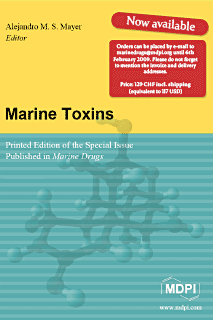Marine Toxins
A special issue of Marine Drugs (ISSN 1660-3397).
Deadline for manuscript submissions: closed (28 February 2008) | Viewed by 463659
Special Issue Editor
Special Issue Information
 |
Printed Edition Availble A printed edition of this special issue is available in two volumes:
Price: 189 CHF (for both volumes, excl. shipping) To order a copy of the printed edition, send an e-mail to [email protected]. Pages containing colored figures are printed in color. A leaflet including the preface is available from following website. |
Benefits of Publishing in a Special Issue
- Ease of navigation: Grouping papers by topic helps scholars navigate broad scope journals more efficiently.
- Greater discoverability: Special Issues support the reach and impact of scientific research. Articles in Special Issues are more discoverable and cited more frequently.
- Expansion of research network: Special Issues facilitate connections among authors, fostering scientific collaborations.
- External promotion: Articles in Special Issues are often promoted through the journal's social media, increasing their visibility.
- e-Book format: Special Issues with more than 10 articles can be published as dedicated e-books, ensuring wide and rapid dissemination.
Further information on MDPI's Special Issue polices can be found here.






